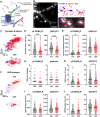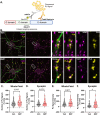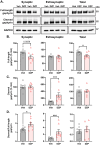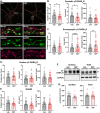Chronic benzodiazepine treatment triggers gephyrin scaffold destabilization and GABAAR subsynaptic reorganization
- PMID: 40686502
- PMCID: PMC12271172
- DOI: 10.3389/fncel.2025.1624813
Chronic benzodiazepine treatment triggers gephyrin scaffold destabilization and GABAAR subsynaptic reorganization
Abstract
Benzodiazepines (BZDs) are important clinical drugs with anxiolytic, anticonvulsant, and sedative effects mediated by potentiation of inhibitory GABA type A receptors (GABAARs). Tolerance limits the clinical utility of BZDs, yet the mechanisms underlying tolerance after chronic exposure have not been thoroughly investigated. Here, we assessed the impact of chronic (7-day) treatment with the BZD diazepam (DZP) on the dynamic plasticity and subsynaptic organization of the gephyrin scaffold and γ2 subunit-containing GABAARs in primary neurons. After functional confirmation of diminished BZD sensitivity, we provide the first super-resolution analysis of inhibitory nanoscale plasticity induced by chronic BZD exposure: gephyrin subsynaptic domains were smaller and the inhibitory postsynaptic area was overall diminished by DZP treatment, resulting in a condensation of synaptic γ2-GABAARs into smaller synaptic areas. Using a novel fluorescence-based in situ proximity ligation assay and biochemical fractionation analysis, the mechanism for gephyrin downregulation was revealed to be dependent on phosphorylation and protease cleavage. Accordingly, DZP treatment impaired gephyrin synaptic stability, demonstrated by live-imaging photobleaching experiments. Despite the loss of BZD sensitivity and stable synaptic gephyrin, 7-day DZP treatment did not reduce the surface or total protein levels of BZD-sensitive γ2-GABAARs, as shown in prior short-term BZD treatment studies. Instead, chronic DZP treatment induced an accumulation of γ2-GABAARs in the extrasynaptic membrane. Surprisingly, γ2-GABAAR interactions with gephyrin were also enriched extrasynaptically. An identified rise in extrasynaptically-localized gephyrin cleavage fragments may function to confine receptors away from the synapse, as supported by a decrease in extrasynaptic γ2-GABAAR mobility. Altogether, we find that chronic BZD treatment triggers several subtle converging plasticity events at inhibitory synapses which effectively restrict the synaptic renewal of BZD-sensitive GABAARs via mechanisms distinct from those observed with short-term treatment.
Keywords: GABAA receptor; benzodiazepine; chronic; gephyrin; inhibition; plasticity; subsynaptic; tolerance.
Copyright © 2025 Chapman, Povysheva, Tarr, Nuwer, Meriney, Johnson and Jacob.
Conflict of interest statement
The authors declare that the research was conducted in the absence of any commercial or financial relationships that could be construed as a potential conflict of interest. The author(s) declared that they were an editorial board member of Frontiers, at the time of submission. This had no impact on the peer review process and the final decision.
Figures







Similar articles
-
Diazepam Accelerates GABAAR Synaptic Exchange and Alters Intracellular Trafficking.Front Cell Neurosci. 2019 Apr 26;13:163. doi: 10.3389/fncel.2019.00163. eCollection 2019. Front Cell Neurosci. 2019. PMID: 31080408 Free PMC article.
-
Increased NMDAR activity and GluN2A-NMDAR silent synapse expansion induced by chronic benzodiazepine treatment.Neuropharmacology. 2025 Aug 5;279:110624. doi: 10.1016/j.neuropharm.2025.110624. Online ahead of print. Neuropharmacology. 2025. PMID: 40754183
-
Psychosocial interventions for benzodiazepine harmful use, abuse or dependence.Cochrane Database Syst Rev. 2015;2015(5):CD009652. doi: 10.1002/14651858.CD009652.pub2. Cochrane Database Syst Rev. 2015. PMID: 26106751 Free PMC article.
-
The Black Book of Psychotropic Dosing and Monitoring.Psychopharmacol Bull. 2024 Jul 8;54(3):8-59. Psychopharmacol Bull. 2024. PMID: 38993656 Free PMC article. Review.
-
Systemic pharmacological treatments for chronic plaque psoriasis: a network meta-analysis.Cochrane Database Syst Rev. 2021 Apr 19;4(4):CD011535. doi: 10.1002/14651858.CD011535.pub4. Cochrane Database Syst Rev. 2021. Update in: Cochrane Database Syst Rev. 2022 May 23;5:CD011535. doi: 10.1002/14651858.CD011535.pub5. PMID: 33871055 Free PMC article. Updated.
References
LinkOut - more resources
Full Text Sources

